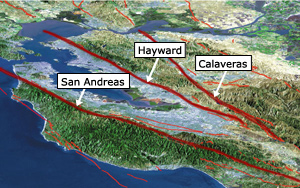|

With at least seven active faults in the Bay Area, small earthquakes are frequent. Here are some of the larger ones of the last 200 years. You can see that San Francisco has had a long stretch of relative quiet, another factor that makes seismologists wonder whether stress is building up for another Big One.
June 1808
Magnitude:
6.0
Fault:
Not known
The
commander of the Presidio reported that a series of earthquakes seriously damaged the walls of his adobe house. From mid-June to mid-July, he noted 21 temblors.
June 10, 1836
Magnitude:
6.7
Fault:
Hayward
This was the first jolt that led to a series of aftershocks for a month. There were reports that the quake created fissures in the earth, and the rumble was felt from the town of Monterey northward and through the Bay Area.
June 1838
Magnitude:
7.0
Fault:
San Andreas
One San Francisco resident present during this quake reported that Telegraph Hill, now the site of Coit Tower, was swaying back and forth, looking as if it would tumble over.
January 9, 1857
Magnitude:
8.2
Fault:
San Andreas
This temblor actually occurred in near Fort Tejon,
just outside of what is now Los Angeles. It is one of the strongest quakes ever recorded in the state. San Francisco residents reported feeling shaking for four minutes, and some buildings incurred damage.
October 8, 1865
Magnitude:
6.5
Fault:
San Andreas
Few houses in the city escaped damage from this quake. Many buildings in the downtown area, including City Hall and the firehouse, were devastated. The
Daily Alta California
described the South of Market neighborhood as “exhibit[ing] lively signs of caving in,” with broken pipes and street lamps, and an inch-wide fissure running two blocks down Howard Street.
A more detailed account from the Virtual Museum of the City of San Francisco
October 21, 1868
Magnitude:
7.0
Fault:
Hayward
Even bigger than the quake that split Howard Steet open, this shaker was followed by a strong aftershock, and threw the town into a panic. The ground in some parts of the city sank by several feet, fissures opened up, and some spouted streams of water that flooded buildings. Pharmacies on Sansome Street reported that bottles and jars were flung off shelves, and many buildings in Chinatown were damaged.
A more detailed account from the Virtual Museum of the City of San Francisco
April 19, 1892
Magnitude:
6.5
Fault:
Not known
This earthquake stopped the clock, literally. The strength of the tremors halted all of the clocks in the Ferry Building, and broke expensive glass and sculptures in the famous Palace Hotel. The quake was centered north of the city, in Vacaville.
March 30, 1898
Magnitude:
6.5
Fault:
Not known
San Franciscans were awakened in the middle of the night when this jolt struck. It toppled many chimneys, and left a school in ruins. The worst damage was reported at a naval base on nearby Mare Island. Congress appropriated $350,000—a significant sum at the time—for repairs.
April 18, 1906
Magnitude:
8.2
Fault:
San Andreas
This is the greatest shock San Francisco has endured in the city's recorded history. Most of downtown was devastated, leaving hundreds of people trapped in the ruins. Fires then swept through the town. The jolt was so strong that it knocked many seismographs from their supports. The readings on those that remained went too far off scale to read. Thus, there are no good recordings of the earth's movements.
You'll find links to 1906 accounts in the
Links
section.
July 1, 1911
Magnitude:
6.5
Fault:
Calaveras
One of the major casualties in this quake was the large telescope at the Lick Observatory near UC Berkeley. One of the observatory's buildings was so damaged it had to be rebuilt. The world-famous telescope, built in 1888 and then one of the most powerful in the world, was shaken and shifted nearly an inch.
October 17, 1989
Magnitude:
6.9
Fault:
San Andreas
Fans attending the World Series game at Candlestick Park were shaken out of their seats when this jolt hit. It was rush hour, and a section of the upper deck of the Bay Bridge collapsed, stranding motorists. Twenty-seven fires broke out in the city, some of them not far from the Exploratorium. Read Mary K. Miller's account of the quake,
Remembering Loma Prieta
.
|






